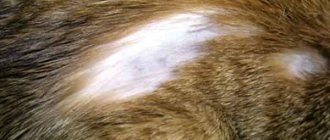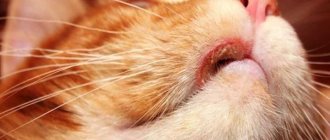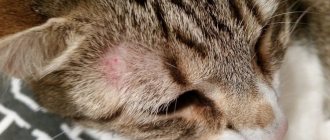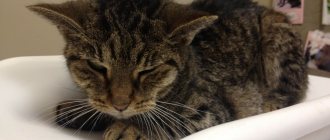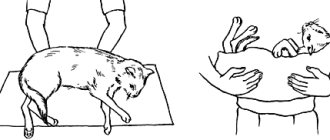Cats are cute creatures, but they not only purr and cuddle, but also scratch. And sometimes they bite, and it’s quite painful, leaving deep wounds with sharp teeth. Bites from outdoor cats are especially dangerous because their saliva contains harmful bacteria. And if the damage is not treated in time, it can lead to serious infections. In addition, such wounds are known to heal slowly and poorly, leaving scars on the skin. What to do if your hand is swollen after contact with a cat? It is necessary to immediately treat the wound and consult a doctor for treatment.
what does a cat bite look like
Why is a cat bite dangerous?
Ignoring treatment for a cat bite will lead to various complications such as tetanus and rabies. Although the cat's injuries are minor, the closed nature of the wounds makes them very difficult to treat. But in most cases, a bacterial infection penetrates under the skin, and this is unsafe for humans, especially with low immunity. Therefore, cat bites should not be treated with disdain, especially if there has been an “acquaintance” with a stray animal. The presence of pathogenic bacteria in the mouth causes inflammation, and such an injury is then very difficult to cure.
What to do if a cat bites you?
As soon as the bite occurs, resort to first aid. Thanks to the right measures to provide it, the risk of developing infections is greatly reduced. First, wash your hands and put on medical gloves. The approach to wounds should always be sterile. Then wash the wound with water and antibacterial soap. It is advisable that it does not contain cosmetics. As a last resort, you can take household goods. This method is good if there is no bleeding.
When bleeding is present, it must be stopped. This is done using a clean cloth. Pressure is applied to the bite site until blood stops flowing. Only after this can the wound be treated with water and soap.
Further treatment consists of the use of neutralizing agents, for example, a solution of hydrogen peroxide or alcohol. Then apply iodine to the wound, after which it is recommended to smear it with an ointment that has an antibacterial effect. After treating the injured area, apply a sterile bandage.
Dressings will need to be done every day using antibacterial agents. Monitor the wound for a week. If inflammation occurs, consult a doctor. In addition to complications with the wound, the need to seek medical help is indicated by the following facts:
- bite of a stranger or stray cat,
- bite in the face or neck area,
- large size and depth of the wound,
- continuation of bleeding
- the victim has not been vaccinated against tetanus within the last five years,
- the appearance of pus at the site of the bite.
These indicators indicate that you need to see a doctor immediately. This is especially important if a child has suffered from a cat bite.
What does a cat bite look like?
Cats, unlike dogs, cannot cause serious injuries. Due to weak jaws and smaller teeth, bites are not as bad, but no less dangerous. Dog bites heal faster than cat bites because they are open wounds rather than closed wounds, as they are after contact with cats. Their thin and small, but sharp teeth penetrate deeply into the muscle tissue, leaving small punctures on the skin. At first they look like a few dots, not inspiring any fear, but gradually the damaged area of the body swells, the bites become covered with scars and look frightening.
cat bite danger
First aid for a cat bite
What to do if bitten by a cat? Remember that the sooner you treat wounds, the less consequences there will be. Therefore, first aid for a cat bite should be timely. To avoid complications, you need to take the following steps:
1. Rinse the bitten area with running water for ten minutes, soaping it from time to time with household (not toilet!) soap, it contains alkali. This will help wash away saliva that contains dangerous bacteria.
hydrogen peroxide
2. Then the injured area must be treated with hydrogen peroxide or chlorhexidine; a solution of furatsilin is also suitable - these drugs do not leave burns on the skin. The edges of each wound must be lubricated with brilliant green or iodine.
antibacterial agent
3. Next, apply an antibacterial agent to the washed and treated area. Suitable drugs: Levomekol, Tetracycline ointment, Gentamicin, Actovegin, Dioxidin, Fusiderm, Tyrosur and Heliomycin.
sterile dressing
4. The last stage is the application of a sterile dressing. Make it loose, this measure is only necessary to prevent dust from getting into the wound. After some time, remove the bandage and apply the ointment again.
If you are bitten by a domestic cat, in most cases home treatment is sufficient. But if you have dealt with a barn cat, then after providing emergency assistance, consult a doctor. The doctor will examine the wound and prescribe the necessary treatment.
What to do?
It is not possible to get rid of swelling on your own in all cases. Sometimes self-medication can only lead to aggravation of the problem, and therefore it is better to consult a doctor.
Treatment of swelling from a cat bite can be done using the following medications and techniques:
| Title and photo | Short description |
| Antiseptics
| They are used in the form of solutions for treating wounds to destroy pathogenic microorganisms and protect tissues from infection. Concentrated products (iodine, brilliant green) are applied only along the contour of the wound surface to protect it from the penetration of new bacteria from the environment. |
| Nonsteroidal anti-inflammatory drugs
| Mainly used in the form of local remedies (creams, ointments). They help eliminate the cause and symptoms of inflammation, in particular, relieve pain and swelling. |
| Glucocorticoids
| When the infection spreads widely, hormonal drugs are required that can stop the inflammatory process in a short time. |
| Antibiotics
| To protect against dangerous bacteria and fight existing infections, your doctor may prescribe antibiotics. For minor injuries, before microorganisms have time to spread throughout the body, antimicrobial ointments are sufficient. |
| Diuretic drugs
| Since swelling is a consequence of the accumulation of excess fluid in the tissues, diuretics may be prescribed to remove it. |
| Traditional recipes for diuretic teas
| An alternative to pharmaceutical drugs can be decoctions and infusions of herbs that have diuretic properties: dandelion root, nettle, horsetail, chamomile. You should not abuse such drugs, as they have contraindications. |
| Homemade compresses and lotions
| For external use, herbal decoctions (chamomile, sage, etc.) are also used to wash the wound. Additionally, the bite site can be treated with ointments and lotions with propolis and aloe juice. |
| Physiotherapeutic procedures
| To improve metabolism in damaged tissues and stimulate the outflow of excess fluid, physiotherapy is recommended: electrophoresis, UHF, phonophoresis, etc. |
| Surgical intervention
| In cases where suppuration or necrosis is detected, the help of a surgeon is required. The wound is sanitized and treated, oxygen is purged, and dead tissue is removed. |
Prevention measures
Despite the fact that swelling from a cat bite in most cases is not a dangerous complication, you should not allow it to develop intensively. It is possible to avoid the development of severe swelling if certain recommendations are followed.
Prevention instructions are as follows:
- Don't rush to stop the bleeding. The blood will partially wash away the bacteria and saliva of the cat that attacked you, which will reduce the likelihood of infection.
- Wash the wound thoroughly. Initially, you need to rinse the damaged area well with clean water, and then additionally use antiseptics, for example, hydrogen peroxide or chlorhexidine.
- Consult your doctor. Even with minor injuries, it is worth visiting a doctor, as he will be able to identify complications in time and administer the necessary medications.
- Care for the wound properly until it is completely healed. It is necessary to change the bandage daily and treat with antiseptic and wound-healing agents, to prevent contamination.
- Get preventive vaccinations in a timely manner. It is impossible to completely prevent infection of the bite site through vaccination, but it is possible to eliminate the risk of developing tetanus. To do this, you should contact the clinic to administer prophylactic antitetanus serum. At school, administering a complex vaccine (DTP-type) to children is a mandatory measure, but adults often ignore this need, putting themselves at risk.
If suspicious symptoms occur and swelling rapidly increases, do not hesitate and immediately seek help from the hospital. You can get more useful information on the topic from the video in this article.
How to treat a cat bite
vaccine
Even if the wound does not seem to cause any concern at first glance, visit a doctor just in case. After all, if you are bitten by a cat you don’t know, there are a bunch of dangerous microbes in its saliva! Do not rule out that the animal is infected with rabies, and if there is even the slightest suspicion, a special serum is injected into the victim. Sometimes, in parallel with it, the patient receives a dose of tetanus vaccine as a preventive measure. Antibiotics are also prescribed, Clavunat or Fluoroquinol, take them for five to ten days.
What not to do about cat bites
iodine deficiency
When providing first aid, you can both help and harm. For example, many people make the mistake of pouring iodine onto the wound after a cat bite. This should absolutely not be done, otherwise the situation will be aggravated by a burn. In this situation, you only need to carefully lubricate the edges of the wound with iodine. Another common mistake is the use of anti-inflammatory drugs. Only antibacterial ointments can be applied to the area damaged by the cat, the rest - only with the permission of a doctor. And also do not self-medicate by taking antihistamines without prescription.
Folk remedies for a cat bite
Traditional medicine is a collection of ancient recipes that have been tested by time. Modern medicines were invented not so long ago, but cats have always scratched and bitten. Since ancient times, people have treated such injuries using folk remedies. Of course, they are, alas, powerless against tetanus and rabies, but they are able to cope with healing wounds and relieving inflammation. We offer five very effective recipes.
calendula
Calendula. Make a compress from a ready-made pharmacy tincture of calendula, or prepare a decoction from the raw materials of this plant. Simply moisten gauze folded several times with a decoction or diluted tincture and apply to the wound.
immortelle
Immortelle. Brew one tablespoon of immortelle flowers overnight, strain in the morning, and drink literally a couple of sips three times a day. There is no need to apply it to the wound, take it orally. This will help relieve inflammation and speed up healing.
walnuts and honey
Honey and nuts. Take crushed walnuts and honey in equal proportions (for example, three tablespoons), add salt and onion juice. Mix and take a teaspoon three times a day. Store the medicine in the refrigerator.
chamomile
Chamomile. Chamomile will help relieve swelling from the bitten area. Pour boiling water over the raw materials (literally a little so that the water barely covers the plant), then grind the mixture so that you get a paste. Apply it to the wound.
snake mountaineer
Snake mountaineer. To prepare this tincture you will need rhizomes, pour dry red wine. The proportions should be 20 grams per 1 liter. You need to insist, shaking, for eight hours, and take 50 grams three times a day.
But do not forget that cat bites should be treated with folk remedies only as additional measures (especially if a domestic cat has bitten), and by no means the only ones. Traditional medicine recipes are only an auxiliary aid to alleviate the condition; they will help you feel better after a cat bite.
Actions after a bite
After a cat bite that does not damage the integrity of clothing and does not cause symptoms of worsening of the condition within 1-2 days, you do not need to seek medical help. However, there are situations in which you should definitely see a doctor, namely:
- animal rabies;
- progression of the infectious process at the site of the bite;
- severe pain in the injured limb;
- loss of consciousness;
- the appearance of seizures and tremors;
- the presence of a large and deep wound, the appearance of significant bleeding;
- fever and deterioration of the patient's condition.
In this case, it is worth visiting a traumatologist, infectious diseases specialist, or at least a local therapist. If acute conditions occur (severe inflammation, allergic reaction), you should immediately call an ambulance without resorting to self-medication.
Visiting a doctor will prevent complications after a bite
Antibiotic therapy, usually prescribed when an infection develops, usually lasts from 7 to 10 days. In cases of cat scratch disease, inflammation of the lymph nodes can last from 3 months to a year, but after this the person acquires stable and lifelong immunity.
In case of infection with tetanus, hospitalization in a hospital is required, and then long-term follow-up for two years. There is no cure for rabies infection.
First aid
If the wound from a cat bite is not very deep and does not require emergency medical intervention, first aid can be provided at home.
In case of bleeding, there is no need to stop it immediately, since the blood can wash the wound of pathogenic bacteria, thereby ensuring an easier course of the infectious disease. The bite site should be treated with a soap solution. Rinse the damage thoroughly and for a long time (at least 10 minutes). To prepare the solution, grate half a piece of laundry, tar or antibacterial soap and dilute it in 500 ml of water. This method is also a protective measure against the rabies virus.
Afterwards, the bite site should be treated with antibacterial ointment, for example Levomekol, and a sterile bandage should be applied on top.
Be sure to wash the bite area with warm water, using laundry or antibacterial soap.
For deeper wounds, before visiting a doctor, you can also treat the damage, thereby preventing serious consequences.
If there is heavy bleeding, you need to stop excessive blood loss. To do this, the wounded limb must be raised above the level of the heart and the damaged vessel must be pressed with a finger above the bite site. Afterwards it is necessary to treat the wound (with a solution of iodine, chlorhexidine, hydrogen peroxide). First, the damaged area of skin should be washed with soapy water and then treated with an existing antiseptic. Afterwards, the bite site should be bandaged, without tightening the wound or closing it in an airtight manner (using a band-aid).
Video: first aid after a cat bite
When providing first aid to a victim, the following actions are prohibited:
- forced stoppage of mild bleeding, tight wound dressing;
- complete closure of the damaged area - bacteria tend to multiply rapidly in such an environment;
- cauterization of the wound, suturing it;
- refusal to visit a doctor: according to statistics, serious illnesses develop when a patient delays a visit to a specialist or refuses it completely.
Further treatment for a cat bite
After a bite, you should definitely start taking antibiotics, and this should be done within the first 24 hours. The most suitable drug is prescribed by the doctor. This may be Amoxiclav, Ceftriaxone, Doxycycline, Levofloxacin.
After two days, a specialist assesses the location of the damage. If symptoms of infection do not appear, then the drugs are discontinued. Otherwise, the antibiotic is taken in full until cure.
The lesions are treated several times a day with Chlorhexidine, Miramistin or another antiseptic, then antibacterial ointment is applied until the swelling subsides and inflammation disappears (4–5 days).
For faster healing of suppuration, it is recommended to take salt baths in which the affected limb is kept. To do this, dissolve 2 tablespoons of salt in a glass of hot water. If necessary, the proportions are increased. Baths are used 4-5 times a day. You can also use salt and alcohol compresses.
For festering wounds after a cat bite, salt dressings are indicated
To make a salt compress, take the same ratio of water and salt as in baths; for alcoholic, medical alcohol is diluted by half. A bandage with a solution is applied to the wound for 20–40 minutes.
Medicines to treat a bite - photo gallery
Amoxiclav is used to prevent the development of bacterial infection
Miramistin is a local antiseptic that cleanses the wound of bacteria
Levomekol has antibacterial and healing properties
Vaccination
The main complications of a cat bite that require immediate immunization are tetanus and rabies.
Rabies vaccine
Vaccination is the only salvation for a person who has been bitten by a cat with rabies. Vaccination should be immediate. Immediately after a bite, the victim should go to the emergency room.
It is especially dangerous to get a bite from a stray animal: even if the cat did not outwardly show signs of rabies, the virus could already be in its saliva.
The attacking animal should be caught and placed in a quarantine zone under the supervision of specialists. If the cat is still alive within 10 days after the attack, then it is not considered infectious. Otherwise, you should start administering rabies vaccine in an amount of 1 ml on days 1, 3, 7, 14, 28.
In the case where it was not possible to catch the cat or it was killed, and it is not possible to make a final diagnosis, the administration of the vaccine begins on the day of the bite according to a similar scheme. This emergency immunization allows both infants and pregnant women to be vaccinated.
The vast majority of Russians who died from rabies did not seek medical help.
Elena Novgorodtseva
Drug Review No. 9 09/26/2014
If the course of anti-rabies treatment is followed correctly, the disease does not develop and does not lead to death. Otherwise, after the incubation period (from 3 weeks to a year), the person will get rabies.
If it is known that the attacked cat was vaccinated against rabies less than 3 years ago, then the animal is healthy and there is no need for vaccination.
Video: how to avoid rabies infection
Tetanus vaccination
Anti-tetanus serum must be administered after a cat bite if the animal is able to walk outside or the previous vaccination has expired (more than 10 years), and also when the victim does not remember the date of the last tetanus vaccination.
Emergency vaccination should be carried out within the first two days after the bite, preferably in the first 6–8 hours.
In accordance with the rules for the provision of medical services in Russia, tetanus vaccination is completely free, it can be given in emergency rooms or hospitals
When vaccinating against tetanus and rabies, it is necessary to take into account the incompatibility of the vaccine with alcohol.
General recommendations
During and after treatment for a cat bite, including vaccination, certain recommendations must be followed for six months to reduce the risk of side effects, namely:
- stop drinking alcohol;
- do not overheat, do not visit baths and saunas;
- do not overcool, dress appropriately for the weather;
- Avoid visiting solariums, beaches and other places with high ultraviolet exposure;
- avoid excessive physical activity and overwork;
- if itching or swelling occurs at the site of vaccine administration, take antihistamines;
- use immunomodulators in the form of food additives during the period of treatment and vaccination.
Symptoms of rabies in humans
after the bite
Signs that a person is infected with rabies most often occur if they are bitten by an outdoor cat. In such cases, it is not recommended to limit yourself to first aid; you must immediately go to the emergency room. There is a high probability that a stray animal will become infected through a bite. Symptoms of rabies in a person after interacting with a cat are not difficult to recognize; the victim’s condition worsens, weakness appears, body temperature rises, the wound festers and becomes inflamed, and bleeding is possible. And you can’t do without treatment.
rabies injection
It is important for every person to understand that signs of rabies do not appear immediately. If you are bitten by a cat, then other than a swollen affected area and painful sensations, you will no longer feel any discomfort. Negative symptoms will appear later, after a week, or even three (depending on where the bite was made). What are these signs? The victim begins to be disturbed by bright light, even to the point of photophobia, and it is uncomfortable to hear loud sounds, which are terribly annoying. In some cases, problems with swallowing and body aches appear. It is important to consult a doctor promptly.
When to see a doctor
It doesn’t matter what area the cat bite occurred in, even if there was a one-time bite on the finger, consultation with a doctor is mandatory, especially if the bite was from a rabid cat. Providing first aid is necessary and very good, but you shouldn’t stop there. Otherwise, there are disastrous consequences, from necrosis to amputation. When should you consult a doctor if you have been bitten by a wild stray cat, and what complications may arise?
infectious disease physician
- Bites on the neck and face - in this case, immediately run to an infectious disease doctor!;
- In case of severe bleeding that cannot be stopped;
- Sudden decline in general condition, poor health and weakness;
- A sharp increase in temperature that cannot be brought down with medications;
- If the wound becomes inflamed, red or blue, pus begins to ooze;
- In contact with a stray cat because it is not vaccinated against rabies.
If you consult a doctor immediately after a cat bite, within 12 hours, you will have every chance of neutralizing the infection without undesirable consequences. The doctor will inject the necessary serum and prescribe the necessary antibiotics.
First aid
Proper treatment of the wound after a cat bite and correct and timely actions help reduce the risk of inflammation.
The following assistance measures are required:
- lightly squeeze the wound to squeeze out the blood - this removes the main viruses and pathogens that get into the wound;
- Rinse the bite area with cool tap water. For more effective treatment, you should use laundry soap - the alkaline environment of a 20% solution helps eliminate many bacteria;
- disinfect the wound with an antiseptic - hydrogen peroxide 3%, furatsilin, miramistin, chlorhexidine or other pharmaceuticals;
- apply a loose sterile bandage;
- apply a cold compress after a cat bite;
- visit a doctor to prevent negative consequences, more thoroughly treat the bite site;
- if necessary, get an injection at the emergency room - vaccination against tetanus for a cat bite and against rabies is included in the list of first aid measures.
Reasons for immediately contacting a doctor are:
- obvious signs of illness in the bitten cat - aggressiveness, active drooling, photophobia;
- an unfamiliar, street animal that has not been vaccinated against rabies;
- heavy bleeding;
- a sharp deterioration in general condition.
It is better to dispel any doubts regarding the further safety of the victim’s condition in the doctor’s office than to regret later about lost chances for treatment after a cat bite.
The animal that caused the injury is observed for 10 days under veterinary supervision, even if the cat is vaccinated against rabies. If there is no proof of vaccination, the animal is often euthanized to examine the pathological material for rabies.
Possible consequences after cat bites
Dangerous complications that provoke cat bites are tetanus and rabies. But even if these diseases are avoided, the consequences of a cat bite are no less serious. We are talking about infectious lesions that arise due to the presence of staphylococci and streptococci in the saliva of animals. They are the ones who provoke inflammatory processes in the body, which will lead to the most disastrous consequences. Namely: sepsis (blood poisoning), tissue necrosis, signs of suffocation, body aches and kidney failure. This is especially dangerous for people with weakened immune systems and diabetes.
Cat bite: danger and consequences
The danger of cat bites is due to the presence of sharp teeth that leave damage to the skin in the form of deep puncture wounds. At the same time, various pathogenic microflora contained in the saliva of animals penetrate into the body and give rise to an infection, the probability of which is more than 80%.
The sharp and thin teeth of cats easily penetrate the deep layers of the skin.
Out of a dozen cats examined, microbes dangerous to humans were found in the saliva of nine of them.
The most common microorganisms in cat saliva are:
- pasteurella;
- streptococci, including pyogenic;
- staphylococci, including methicillin-resistant aureus;
- Neisseria;
- fusobacteria;
- bacteroides;
- porphyromonas;
- Moraxella.
The most typical representative of pathogenic bacteria is Pasteurella, the causative agent of pasteurellosis (acute infection). Since most bites occur on the hands, the microflora of cat saliva and human skin can interact with each other, which will aggravate the course of the disease.
Pasteurellosis is manifested by severe swelling and redness of tissues
It is also most dangerous if the infection enters the blood and spreads to vital organs.
Both bites and scratches from a cat's claws can cause benign lymphoreticulosis, also called cat scratch disease. Clinically, it appears after the affected area has healed and can lead to either mild fever or more severe meningitis. Children who like to play with cats and kittens are primarily at risk of contracting this disease. The younger the animal, the more likely it is to develop lymphoreticulosis.
The greatest danger comes from bites on the face, neck, and joints of the hands and genitals - all these places are shrouded in a large network of nerve endings through which the infection spreads. For example, the rabies virus moves along the nerves 3 mm per hour until it reaches the brain.
It is important to pay attention to the depth of the bite: in case of serious wounds, see a doctor immediately. If the victim is a child, a pregnant woman or an elderly person, a visit to the doctor is mandatory in any case.
The danger of the situation lies in the lack of proper attention to skin damage from an attack by this animal. Even if the bite is initially minor, infection can penetrate the wounds and lead to serious consequences.
A bite wound festeres 4 times more often than a wound of other origin
People's reviews about cat bites
The cat bit my mother in the ankle area. The bite is strong and deep. Well, they smeared it with green paint, treated it with peroxide - tea, not for the first time... But it didn’t work out that way - the leg became inflamed, swollen, and there were red spots and lumps at the site of the bites. It hurts a lot. Mom lives in the Moscow region, and their healthcare, frankly speaking, is not so hot. I went to a traumatologist, who prescribed antibiotics and a vodka compress. A week passed - still at the same time. I went to the surgeon - he said that there was pus inside, he picked everything out, washed it out, prescribed another antibiotic and told me to apply any ointment so that the wound would not heal. A week has passed - maybe a little better, but the swelling does not go away, my leg hurts, and the wound has healed.
Marylit
https://mauforum.ru/viewtopic.php?f=36&t=9447
Two months ago I was bitten by a cat, right in the articular part (and very close to the tendons), I’m not a doctor, so I’ll explain everything in my own words. The bite was deep, I immediately treated it with alcohol, the wound healed, but there was a lot of pain in this area (the pain was dull, similar to a nerve), there was no suppuration! It’s been 2 months now and the finger still hurts terribly when the tendon is loaded, the joint area itself doesn’t hurt and doesn’t hurt when it’s at rest either. Pain due to movements, in that place when palpated there is “nerve pain”.
derskiller
https://www.medlinks.ru/modules.php?op=modload&name=Forum&file=viewtopic&topic=55105&forum=125
The cat bit me very badly, the wounds festered, but the doctor cleaned everything and made a mash for lotions, the wounds healed, but seals remained at the site of the bites.
Victoria
https://www.woman.ru/health/medley7/thread/4537416/
As follows from the reviews, cat bites are not at all harmless and pose a danger to both small children and adults. The greatest threat is posed by street animals that feed on birds and mice, as well as various wastes. The content of pathogenic microorganisms in their saliva is several tens of times greater than in the saliva of a domestic animal.
The likelihood of infection increases significantly when bitten by an outdoor cat.
Among other things, when bitten by a stray cat, the likelihood of contracting such dangerous diseases as rabies (hydrophobia) and tetanus increases. In the first case, you can determine the disease by the appearance of the animal. In this case, the following signs will be typical:
- aggression and anxiety;
- increased vocalization (the cat meows often and loudly);
- lack of appetite;
- foaming at the mouth;
- photophobia and hydrophobia;
- convulsions and paralysis of the animal.
A domestic cat that sometimes walks in the garden or outside for a short time can also pose a danger. When the above signs appear, the animal is infectious within several days, which is a big problem. According to statistics, young cats under 3 years of age are especially dangerous.
The rabies virus is detected in the saliva of infected animals 7–10 days before the first clinical signs appear.
Tetanus is the second most dangerous complication from a cat bite. The disease affects the nervous system and provokes spastic muscle contractions. The microbes that cause tetanus live in the soil and get into the saliva when animals lick their fur.
Thus, the consequences of a cat bite can be:
- clostridial infections;
- rabies;
- parasitic diseases;
- sepsis;
- allergic reaction;
- infectious cellulitis;
- abscess and phlegmon;
- inflammation of the lymph nodes;
- toxoplasmosis;
- dermatitis and dermatoses (ringworm is especially common).
